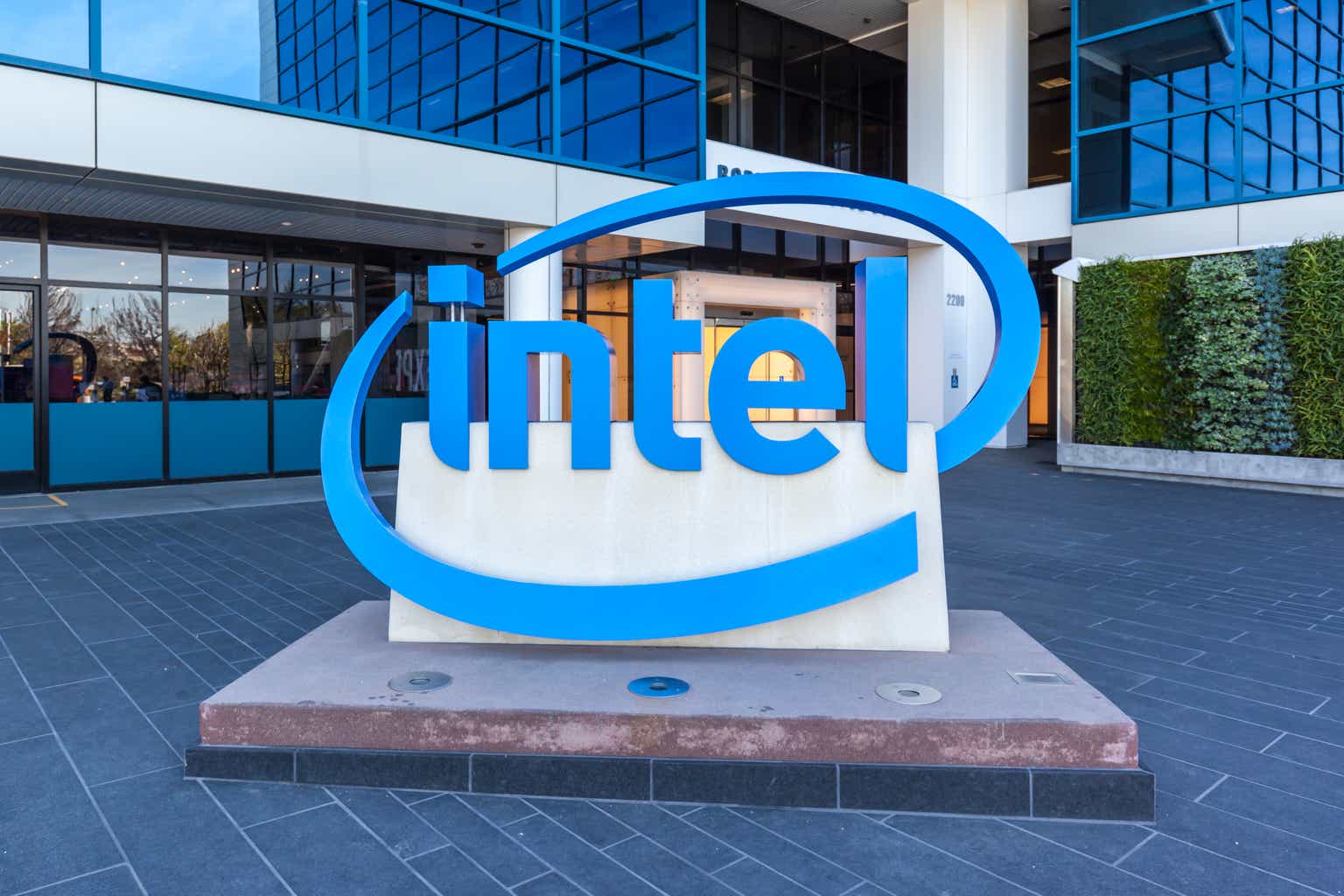JHVEPhoto
Investment thesis
Intel (NASDAQ:INTC) reported decent Q4 results, which were overshadowed by the subpar Q1 guide. This could, however, be seen as Intel now growing high single or low double digits after its financial reset in 2023, so overall Intel is actually making steady financial progress. Apparently this progress is slower than analysts had expected, but there are some additional headwinds (worth a relatively significant $1B) in Q1 such as the five exited businesses, Mobileye (MBLY) inventory correction, legacy IFS packaging subsiding and the FPGA correction, while the core businesses are more seasonal. With regards to the stock, even before the earnings report the stock had arguably become overvalued in the near-term, getting quite far ahead of expectations and results.
Of course, depending on one’s cost basis in the stock, Intel missing the AI boom to Nvidia (NVDA) and the lowered financials both mean the stock will struggle to get back to levels seen in prior years. In the big picture, though, the steady financial and technological progress in the wake of the macro downturn should encourage long-term investors to add on the dip as the stock goes back towards $40 or below.
In short, the technological turnaround thesis, which is seeing its inflection in this upcoming year, remains exactly on track, adding $6B foundry total deal value in 2023. However, the recent financial results have indicated and confirmed the financial reset in the wake of the prior COVID-19 growth, which will likely take far longer to digest than expected, measured perhaps on the order of years.
So directionally, investors should be looking for high single digit growth from the $54B level, which Intel will quite likely be delivering in 2024. However, given the current investment phase and the fact that this is high fixed cost business with revenue down from the $77B mark a few years ago, the stock was valued too high.
The stock is ultimately still very much investible for the long-term. As discussed in prior coverage, though, even after the turnaround it could still take years to see tangible financial results, as in AMD’s (AMD) case. However, the more steady/slow financial progress following the downturn means a definite likelihood remains of revisiting levels in the $30s or even high $20s, before eventually going higher.
Background
The technological side saw significant progress late last year with the signing up of the first 18A foundry customers, providing the most definite confirmation that Intel has flawlessly executed its roadmap.
This was followed by solid further sequential earnings results in Q3.
More recently, in December Intel launched its last major set of pre-turnaround products. Looking forward to 2024, in just one year Intel would advance its technology by an amount that is taking TSMC no less than eight years (or actually close to nine years considering TSMC’s backside power delivery likely won’t launch before 2027), leapfrogging to industry leadership. However, with the stock price being around a multi-year high, basically baking in a full recovery for which there was no evidence yet, it had become overextended: the provided napkin math argued $2 in EPS had been wiped out, which would support a current valuation around $30 (perhaps a bit higher when being forward-looking).
Q4 and 2023 results
The precise results are available here.
Overall, Intel’s financials improved steadily through the year, as it had predicted. Of course, Intel originally expected that Q2 and Q3 of 2022 would already be the bottom, and even H2 2023 was previously seen as the recovery period. At least for Intel, instead the recovery is going to continue well into 2024 and perhaps beyond.
From that view, Intel is going through some sort of financial business reset. While it is less convenient for existing (long-term) investors, basically the performance from Q2 2022 onwards should be seen as the new baseline. In addition, investors should also realize that the 2020-21 results were exacerbated by probably at least a few billion dollars due to the COVID-19 demand.
This explains the magnitude of the revenue drop seen in recent years. Basically, one has to acknowledge that the thesis (in addition to that of a quick 2022 bottom as just mentioned) as laid out by Intel at its 2022 investor meeting, namely of growing (at least) mid to high single digits from a 2022 baseline of $76B revenue, was far too optimistic in hindsight. Note that Intel was expecting this (up to high single digit) growth already before any progress from its technological turnaround materialized.
On the PC side, the TAM, after falling post-COVID-19, now seems to be stabilizing again, and the inventory correction has also passed, resulting in revenue up 33% YoY. The data center has seen a similar decline and stabilization, although this one has not seen any uptick yet. In the data center, there is likely more market share erosion (Intel noted a stable 2023 share for the PC, and for DCAI from Q3 to Q4) and some spending shift towards accelerators (read: Nvidia). Lastly, NEX has also seen a decline, which as detailed by Seeking Alpha started a few quarters later, although Intel does expect growth in H2 2024.
Bottom line, with the COVID-19 surge in the rearview mirror, many exited businesses and AMD has grown into a quite potent competitor, over the last year a clearer picture of the current baseline Intel financial performance has emerged, which is not one of $76B revenue, but rather lower.
Of course, the above is what had been expected since the Q1 guide a year ago, but the reaction to the Q1’24 guide shows many are/were apparently still comparing to those previously achieved revenue levels, but there are simply no signs of another COVID-like surge.
Q1 outlook overblown
Instead, it is now this $54B result that Intel will comp in 2024. ‘Luckily’, comping $54B is rather easier, and so the goal would be to continue to grow YoY going forward. That is exactly what Intel set out to do in Q1 and beyond, and therefore the criticism Intel received has been overblown.
As noted, using the $76B as a measuring stick is simply not possible anymore, although management certainly could have received some tougher questions on how its investor meeting 2022 revenue forecast (for which it said it didn’t use any heroic assumption) could nevertheless be off to the tune of $20B (even when accounting for the inventory corrections): basically Intel now seems to be growing mid to high single digits (in line with its forecast), but from the $54B level instead of the $76B level.
Note that the overall technology turnaround thesis remains valid, but the associated financial details (unfortunately) clearly must be revised from those presented at the 2022 investor meeting. Nevertheless, Intel didn’t even provide a formal full-year 2024 outlook, never mind an update on its long-term targets. Even a broad 2024 range might have encouraged some investors of steady progress (and perhaps discouraged others).
But from that view, while the Q1 guide was below estimates, which were calling for just a slight seasonal decline, the guide is still up YoY (by 8%, which with a beat could mean low double digit growth) from the admittedly horrendous Q1’23. In addition, Intel seemed to suggest that Q1’24, like Q1 last year, should be seen as more of an outlier quarter to the downside.
If the guided YoY performance continues, then revenue could approach $60B in 2024 (which is in line with estimates or above the revised ones). This is still far from even the years preceding COVID-19, but with a PC TAM of over 270M units, the main culprit is the decline in DCAI and NEX. The latter should in principle be fully recoverable, while the former always depended on the 2024-2025 turnaround, which is only just starting (with Sierra Forest in Q2), as investors have had to patiently wait for since 2020-21.
Elaborating on Q1 as an outlier, the (last) major point regarding the Q4 to Q1 performance/outlook is that the “subseasonal” performance is actually mainly caused by the non-core businesses (as well as by the business units that have been exited), with Intel actually more or less indicating that the PC and non-FPGA DCAI segments would see more seasonal trends, although still representing double digit declines.
Specifically, Intel called out a $1B hit QoQ from non-core businesses: the Mobileye and FPGA inventory corrections, the subsiding of legacy packaging revenue from COVID-19 shortages, and the five exited businesses in 2023. One might take this to mean that revenue guidance otherwise could have been a more solid $13.7B. These trends also further confirm the view of establishing a new revenue baseline.
While we expect a slightly subseasonal first quarter from our core product businesses, we see material inventory corrections in Mobileye and PSG. Additionally, we expect a significant drop in IFS revenue after seeing accelerated purchasing in our traditional packaging business and cyclical weakness in wafer equipment buying in the first half of the year, impacting the IMS business. When combined with businesses we exited in 2023, we expect a roughly $1 billion sequential revenue impact from businesses outside of our core products.
Looking further out, like 2023 then, Intel is forecasting both YoY and QoQ growth from Q1 through the year. Intel is also expecting EPS to grow faster than revenue, roughly breakeven adjusted FCF, and continues to see a 60% gross margin fall-through based on additional YoY revenue. Intel further expects $2B additional depreciation and said 2024 would be the year with the highest start-up costs. This also marks the start of the internal foundry model, which will allow for more direct comparisons to foundries like TSMC on one hand, and fabless companies likes AMD on the other hand, with (as expected) Intel mentioning the manufacturing P&L under pressure given its uncompetitive position.
Revenue walk (2020 to 2023)
As noted, one simply must concede the business changes over the last few years:
- The COVID-19 surge and following downturns and inventory corrections in all three of Intel’s major businesses, with neither NEX nor DCAI showing any recovery at all yet.
- The loss of data center market/revenue share (or conversely, rise of AMD), as well as the rise of AI accelerator revenue (spending shift, rise of Nvidia).
- The loss of Apple’s (AAPL) silicon business as well as other lost businesses such as 3D XPoint and NAND, and the Apple modem business.
Overall, these dynamics are making the current roughly $60B estimate quite reasonable. For example, if AMD had grown even more (captured more PC market share), then Intel’s results could have declined far more, as the bear thesis had predicted. Again, from that view there are worse outcomes than an up to double-digit growing Intel from a $54B baseline.
For a bit of a revenue walk (rounded to $0.5B), taking the $77.5B revenue from 2020 as baseline:
- Roughly $2.5B lost from the modem and perhaps other exited PC adjacency businesses.
- Roughly $2B lost from the Apple silicon transition.
- Roughly $5.5B lost from the NAND business sale, likely totalling $6B including 3D XPoint.
Excluding these businesses, Intel’s revenue in 2020 likely would have been on the order of $67B instead. Further:
- Roughly $3B lost (compared to 2021) due to the ongoing correction in NEX of over $0.5B in quarterly revenue.
- IoT (part of NEX) grew $1B from 2020 to 2021.
- Roughly $7B lost in DCAI compared to 2020-21.
This brings the (preliminary) 2023 revenue at $58B. On the PC side, CCG (laptop + desktop) did roughly $35.5B in 2020 and $37.5B in 2021 revenue, compared to a baseline of over $32B prior to COVID, implying a COVID-19 surge of roughly $3-$5B. Instead, PC CPU revenue dropped to $29.5B in 2022 and $27B in 2023, hence down by $6B from pre-COVID-19 levels. Using $33B as baseline PC revenue:
- Roughly $2B lost from the post-COVID-19 cool-down.
- Roughly $6B additionally (temporarily) lost from the inventory correction.
- Somewhere in this PC math is the $2B double counted Apple silicon (i.e. $31B would become the new baseline).
- About $2B gained from Mobileye and IFS.
The result is roughly $54B revenue, close enough to the actual result of $54.2B.
Looking at this revenue walk, while expecting anywhere close to $76B revenue seems unrealistic (given over $10B in exited businesses alone), there are a few opportunities for growth:
- Roughly $3-$4B by going back to pre-COVID ($30B+) PC CPU revenue (excluding Apple). This shouldn’t be unrealistic since the TAM has remained above those levels even through the downturn.
- The $3B lost in NEX (which as a reminder was described as a mid-teens growing business).
- Many billions from potentially gaining back market share in DCAI, improved pricing and TAM growth (also described as a mid-teens growing market).
- Many billions (on the order of e.g. $20B) from taking share from what seems to be becoming a $50-$100B data center accelerator market for Nvidia, and perhaps a few billion in gaming as well.
- Many billions (on the order of $20B) by achieving its target of becoming the world’s second largest foundry.
- Many billions (on the order of $20B) as Mobileye scales its L2+ (SuperVision) through L4 product lines (with 10-100x average selling price over its legacy ADAS business, compared to $2B mostly legacy ADAS revenue).
In the near-term, scaling back towards $60B seems feasible by growing back the PC and NEX businesses, with perhaps some contribution from DCAI. How much of the $7B in lost DCAI revenue is recoverable in the near-term is perhaps the main question mark, depending on market share loss vs. market contraction during the downturn (and subsequent recovery).
On the competitive side in DCAI, one should consider how long it takes to ramp new product lines. Intel disclosed selling 2.5M Sapphire Rapids in 2020, which is probably about low double digits of its total units at best, with Ice Lake (originally a 2019-2020 product) hence representing the vast majority of 2023 sales.
For further growth, given the recent disclosures, it seems little should be expected from IFS and Mobileye in 2024. The same goes for gaming and AI, with the $2B total Gaudi pipeline also still small, especially compared to Nvidia’s results.
Business updates
Intel updated its metric for foundry lifetime deal value, now valued at $10B, up from $4B last year. Towards Intel’s quest to become the second largest (external) foundry by 2030, already adding $6B annually during the early years of this business, which is still largely pre-revenue, should be considered solid, showing its potential. As Intel noted on the call, 75% of its 50 test chips over the next two years are on 18A, now with four customers formally signed up on the node, as well as several advanced packaging ones.
This already shows the importance of getting back to technology leadership, which had been the key thesis. After having had to endure so much scepticism regarding its ability to ever regain process leadership, doing so in such a timely manner is quite encouraging. Regarding this progress, restoring process leadership has now changed from some goal far on the horizon to just another point on the current year’s roadmap (although the actual product launches are scheduled for H2’25):
Intel 18A is expected to achieve manufacturing readiness in second half ’24, completing our five nodes in four year journey and bringing us back to process leadership. I am pleased to say that Clearwater Forest, our first Intel 18A part for servers has already gone into fab and Panther Lake for clients will be heading into Fab shortly.
The 1.0 PDK is scheduled for Q2. With the foundry event scheduled for next month, Intel is now ready to start disclosing its roadmap beyond 18A:
As we complete our goal of five nodes in four years, we are not satisfied nor are we finished. We have begun installation of the industry’s first high NA EUV tool in our most advanced technology development site in Oregon aimed at addressing challenges beyond 18A. We remain focused on being good stewards of Moore’s Law and ensuring a continuous node migration path over the next decade and beyond.
Even if Intel is still some way from delivering strong investor returns (beyond $50), the alternative path that was heavily discussed in 2020 was falling into irrelevancy. So, to be signing up four 18A foundry customers less than four years later, having by now mostly completed an ambitious roadmap without any delays, is already quite the turnaround.
Intel did receive a question on the call, since for the second consecutive quarter TSMC (TSM) for its parts claimed that its N3P would actually be on par or achieve leadership against 18A, which Intel yet again debunked. Without any public information to verify or falsify any claims, on the surface one might nevertheless side with Intel, as 18A would be its second-gen RibbonFET, combined with PowerVia, neither of which N3P has. In addition, as an actual TSMC foundry customer, Intel has access to the N2 PDK, unlike TSMC as PDKs are generally under NDA.
In DCAI, Intel said it saw stable market share from Q3 to Q4 and record ASPs from increased product core count. In DCAI, the main product line besides Xeon is Gaudi, with Gaudi3 (with 4x performance) still scheduled for 2024, and the pipeline growing double digits QoQ to over $2B. Unfortunately, although crucial, neither of these points are that noteworthy given Nvidia’s scale and Gaudi3 launching nearly two years behind H100 (both on a similar process node), although it should achieve leadership performance against this part and likely should even be competitive against B100.
In addition, Intel noted that it already has a TCO advantage/leadership with Gaudi2, which shouldn’t be surprising given Nvidia’s premium pricing. Nevertheless, analysts may have asked what then prevents the Gaudi pipeline and revenue from growing faster. In addition, details about Falcon Shores, which seemed to be scheduled for early 2025 and based on angstrom-level process tech, remain unconfirmed and even seem unlikely (given that Gaudi3 is still a while from launching, and the product has lacked from any of Intel’s process tech discussions in the last 1-2 years).
In CCG, Intel provided a forecast for 40 million AI PC (read: Meteor Lake) shipments expected in 2024, indicating a healthy ramp. For comparison, about one year after launch, Intel said “Tiger Lake has shipped more than 70 million units this year, making it our fastest-ramping notebook ever.” Of course, this was during the COVID-19 surge, and Intel also launched some Raptor Lake-Refresh parts alongside Meteor Lake.
Final thoughts
Obviously one would have preferred to see a quicker return to all-time high financials, more in line with the disclosures at the investor meeting. (Even at the time some were already skeptical about its growth targets.) But doing the revenue walk, considering all the businesses Intel has exited and the corresponding lack of businesses to drive meaningful growth in the near-term (with instead even declines in some of these adjacent businesses), provides a far more realistic view.
Solid full-year growth from 2023 levels remains readily possible, though.
Investor takeaway
As argued, the times of revenue on the order of $76B are past (for now), which has implications for Intel’s (near-term) valuation: the stock had run up too far and fast. Given the magnitude of the ongoing investments combined with the decline in revenue, purely based on earnings the stock should be a lot lower. Given the stock’s historical tendency to sell at a 10-15x multiple at best, it could actually easily go back to its 2022-23 lows. As a revenue walk has further illustrated and confirmed, the near-term revenue potential really doesn’t seem to go far beyond the $60B mark.
In the long-term, the company/stock remains compelling as a doubling in revenue could be possible based on for example $20B Mobileye (although this has become its own stock), $20B in IFS and $20B in AI accelerator revenue. Unfortunately, even three years into Pat Gelsinger’s appointment as CEO, these three main emerging businesses remain years from showing any such scaled revenue.
As such, while Intel was criticized heavily due to what was seen as a low Q1 guide, the focus for investors should be to gauge progress in scaling revenue consistently in the high single digits from a combination of market growth and improved product execution (as detailed during its 2022 investor meeting), from the new $54B baseline revenue. In that regard, Intel’s Q1 guide (and directional comments for the rest of 2024) was (were) consistent with that outlook.
So as the financial progress is being set back by years as the post-COVID-19 reality is setting in, which as acknowledged likely also sets the stock back by years, this has to be balanced by the technological progress, which does remain on schedule, and as such (at the very least) clears the way for a more competitive future. Nevertheless, the actual financial benefits from achieving technology leadership could still take a few more years to be fully realized.
Overall, there simply had never been anything on the horizon to justify the run up towards $50. Instead, delivering around high single digit growth in the wake of the 2023 financial reset seems reasonable. On the business side, with Clearwater Forest now in the fab and hence restoring Intel’s once unquestioned process leadership, perhaps the main 2024 product investors should be looking for (which could perhaps see a near-term inflection in revenue) would be the launch and scaling of the Gaudi3 pipeline (a leadership product).
Credit: Source link










































